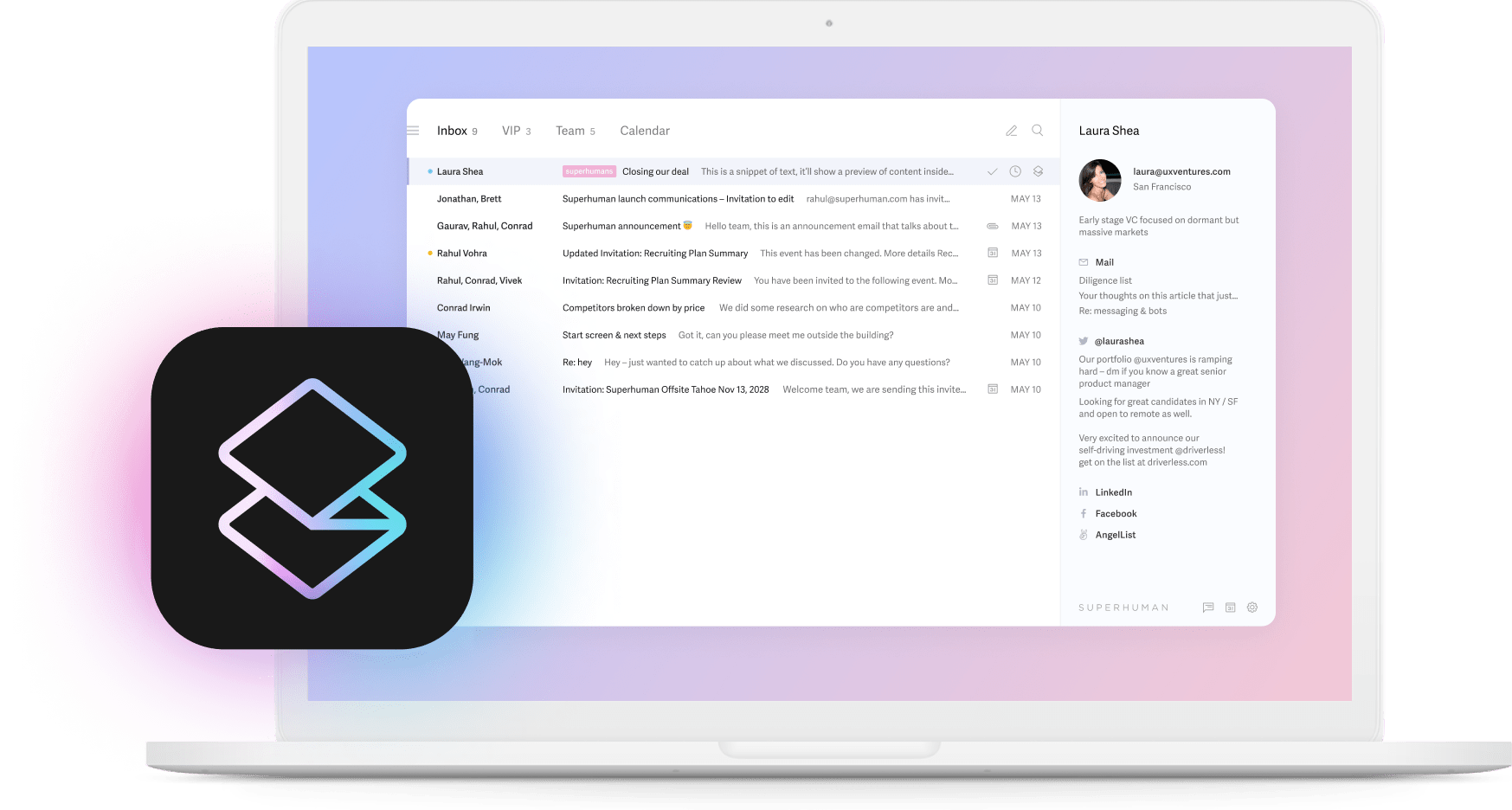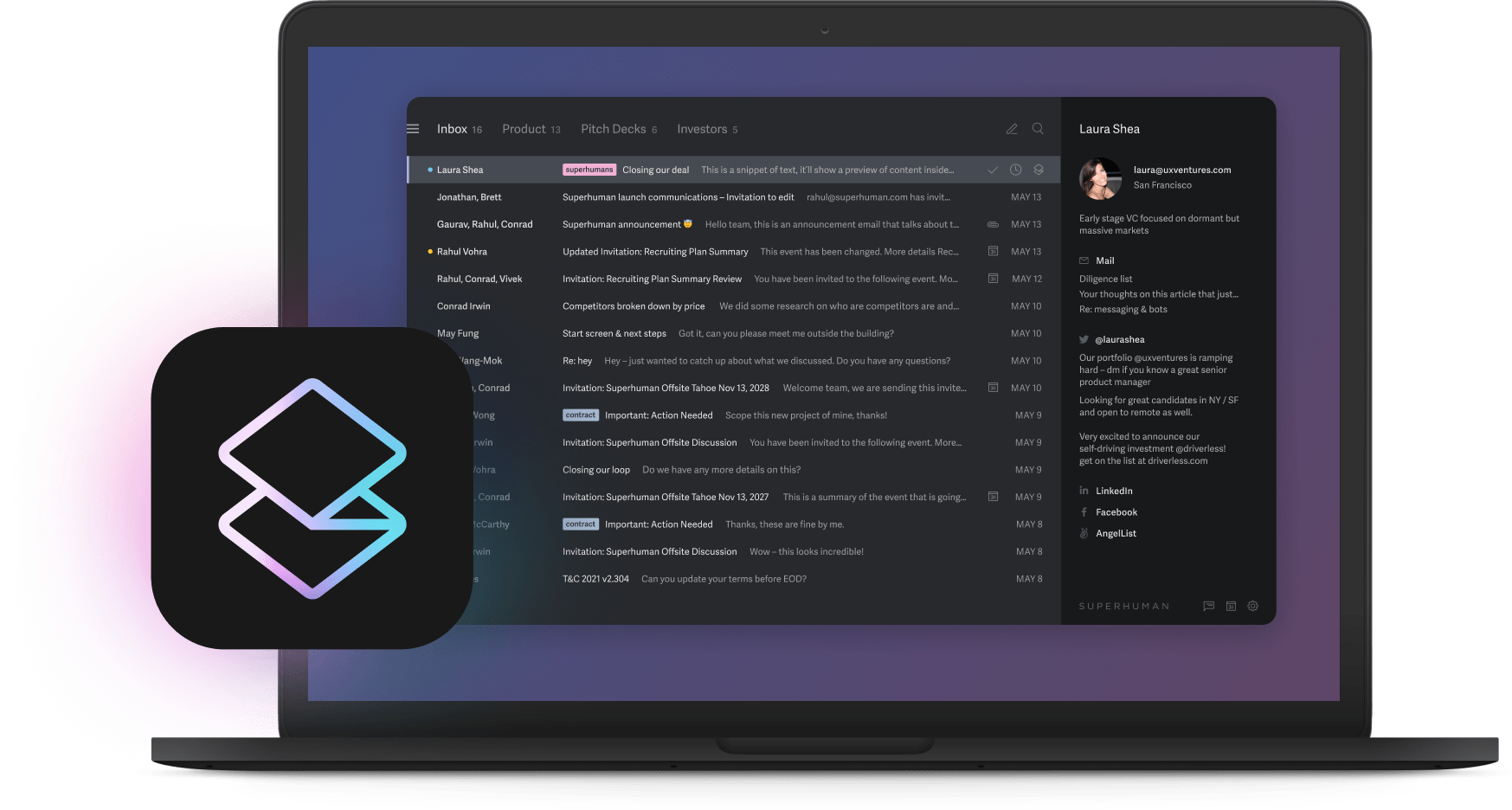
Most people consider 'CC' and 'BCC' in emails to be fancy add-ons they can safely ignore.
Trust me, I’ve been there and done that.
As a matter of fact: Ignoring these features can lead to messy email threads, embarrassing blunders, or worse, annoyed colleagues.
In this guide, you’ll learn what CC and BCC mean and how to use them correctly.
Table of Contents:
If you want to improve your email etiquette and be more effective at work – this guide is for you.
Let’s dive right in.
What does CC mean in email?
The CC abbreviation stands for Carbon Copy.
It lets you send a copy of an email to one (or more) recipients in addition to the primary recipient. All in one go. No need to send additional emails.
The CC field is often used when you want to keep someone informed about an email conversation but don't require their direct participation:

Let’s say you’re working on a project with your colleague and want to keep your boss in the loop about how things are going.
Instead of sending a separate email to your boss, CC them in your emails to your colleague. Your colleague will get the email as usual, but your boss will receive an identical copy of the email.
This way, your boss stays in the know about the project status without diving into the nitty-gritty of your conversation with your colleague.
When to Use CC?
Using the CC feature in email can be pretty handy in different situations such as:
- Sharing information for reference: CC is your go-to move when you want to fill someone in on an email conversation or project progress, but you're not looking for an immediate response. CC them and they’ll stay in the know.
- Group email: When emailing an email group recipients, use CC to include people who need to be aware of the message but aren't the primary audience. For example, if you're sending a department-wide announcement to employees, you might CC the department head for awareness.
- Introducing contacts: When introducing two people via email, CC both parties. This way, they can see each other's email addresses and have a reference for the introduction.
- Transparent communication: Use CC to keep things transparent in a team or organization. For example, when you're tackling an issue or making a group decision, CC relevant team members. Everyone's on the same page, and it's all out in the open. This is especially important if you're managing (or part of) a remote team.
Optional Reading: 7 tips on writing goods email and banish sender's remorse.
When Not to Use CC?
You need to be thoughtful about who needs to be copied and only include those who are relevant to the message. Here are instances when it’s best to avoid using CC:
- Sensitive information: Don't use CC for emails with confidential or sensitive information. CC’ed recipients can see the email content. If the information is meant for the primary recipient's eyes only, consider alternatives like secure messaging or encrypted email.
- Passive-aggressive communication: Using CC to subtly call someone out or make a point can create a tense atmosphere. If there’s an issue, address it openly and directly.
- Misuse of contact information: Respect the privacy of others and refrain from using CC to share email addresses without permission.
Where to Find the CC Feature in Email?
In Gmail, Microsoft Outlook, and Yahoo Mail, you will find the ‘CC’ field to the right of the ‘To’ field while drafting a new email.
For example, here are the CC and BCC fields in Gmail:
In Superhuman, press the down arrow or use the Cmd+Shift+C keyboard shortcut to quickly CC recipients:


What does BCC mean in email?
BCC stands for Blind Carbon Copy.
It allows you to send an email to multiple recipients without revealing their email addresses to each other.
When you use BCC, each recipient can see that they received the email, but they can't see who else got it. This helps maintain privacy and prevents a long list of email addresses from cluttering everyone's inboxes.
Let’s say you work at a SaaS marketing agency, and you’re sending a report to your client. But you also want to keep your internal team in the loop without exposing their email addresses to the client.
What do you do? You put your client's email in the 'To' field, and your coworkers go as additional recipients in the BCC field.
That way, your client sees the email as usual, but your team receives a copy without their email addresses being revealed to the client. It's a nifty way to keep things confidential.
On Superhuman, you can automatically BCC your sent emails to CRM tools like HubSpot or Salesforce:
Hit Cmd+K → Auto-Bcc Settings, or head to Settings in the mobile app.
This feature is especially helpful for sales or customer success teams using Hubspot or Salesforce to track customer interactions.
When to Use BCC?
Use the BCC field when you want to send emails to many recipients without revealing their email addresses to each other. Here are some common scenarios when it’s a good idea to use BCC:
- Protecting privacy: Use BCC when sending an email to a large group of people who may not know each other or when you want to respect their privacy. It keeps everyone's email addresses a secret from each other.
- Mass emails: Sending out mass emails, like company newsletters or announcements? Use BCC. It ensures that everyone receives the email individually and privately, avoiding a long list of email addresses in the "To" or "CC" fields.
- Event invites: When sending invitations for events, using BCC helps keep the guest list under wraps. Each person gets their invitation without seeing who else is on the list.
- Forwarding conversations: When you're forwarding an email conversation to someone but want to keep the original recipients' email address under wraps, think BCC. It's a discreet way to share info.
- Documentation: Need to keep records? BCC yourself on emails, and you’ll have a copy of the email chain in your own inbox for future reference.
- Introductions: If someone introduces you by email, be considerate of their inbox. Move them to BCC to spare them from the ongoing conversation.
Superhuman makes this easy with Instant Intro. Thank the introducer, move them to BCC, and start responding. With one click:
When you receive an intro, hit Cmd+K → Instant Intro (or Cmd+Shift+i). On mobile, simply tap the "Instant Intro" button.
Optional Reading: How to create a group email in Gmail.
When Not to Use BCC?
The key is to use BCC responsibly and in ways that respect the expectations of your email recipients. Here are email situations when it’s not the right fit:
- Personal touch: If you're sending a personal message, like a heartfelt thank-you note, BCC isn't the way to go. It can make you seem impersonal and distant.
- Direct conversations: When you're having a one-on-one or a conversation with a small group, BCC isn't needed. It's more appropriate to use the "To" or "CC" fields to keep things straightforward.
- Transparent communication: In situations where transparency is important, avoid using BCC to maintain open and transparent communication.
Where to Find the BCC Feature in Email?
In Gmail, Microsoft Outlook, and Yahoo Mail, you will find the ‘BCC’ field right next to the ‘CC’ field, while drafting a new message.
As a Superhuman user, you can press the down arrow or use the Cmd+Shift+B shortcut to BCC recipients.
CC vs BCC: How to use them correctly?
You might think using 'CC' and 'BCC' in emails is as simple as adding the addresses and hitting send.
But it’s not that simple. Misusing these can lead to awkward situations and email clutter.
In this section, we’ll share some best practices on using CC and BCC correctly––and make your email game stronger.
How to Use CC Correctly?
Be selective
When using CC in your emails, be selective in choosing who to include. Only CC individuals who have a direct need for the information or who are relevant to the conversation.
Here are some factors you can consider while deciding who to CC:
- Relevance: Do they have a direct need for the information?
- Purpose: Are you CC’ing them for their input, awareness, or documentation?
- Prioritize: If they’re actively involved, should they be the primary recipient?
Being selective like this helps keep your emails sharp and to the point, without overloading inboxes or causing confusion.
Be clear when you CC
When CC-ing someone in an email, make sure your message is crystal clear about why the recipient is being copied.
Provide a brief but clear explanation of why they’re receiving the email—what you're expecting from them or what their role is in the conversation.
When you’re clear, recipients understand their involvement. This reduces any potential confusion, making your email communication more effective.
Sidenote: If you’re a Superhuman user, you can quickly add people to BCC by hitting Cmd+Shift+B.
Respect privacy
Always respect the privacy of individuals when CC'ing them in emails and avoid sharing their email addresses in the CC field.
If you feel the need to share someone's email address with others in the CC field, ask for their permission first. Not everyone may be comfortable with their email address being visible to other recipients.
How to Use BCC Correctly?
Write descriptive subject lines
When you BCC someone in an email, they receive the message without knowing who else is included. In such cases, a descriptive subject line helps them understand the email's relevance.
By crafting a clear subject line, you ensure that BCC recipients can immediately grasp why they've received the email, what it's about, and how it pertains to them. This avoids confusion, helps them prioritize their response, and ensures that they can efficiently manage their inbox.
Further Reading: How to write better emails.
Use BCC sparingly
You might be tempted to add a bunch of people to the BCC field. Don’t.
BCC is ideal for certain situations but overusing it can make you seem impersonal. When appropriate, consider sending individual or personalized emails to maintain a personal connection with recipients.
Here’s the deal: transparent communication builds trust.
When you BCC someone without their knowledge, it might make them wonder about the email's purpose or why they were included secretly. Sometimes, it's better to be upfront about who's getting the email.
Don’t use BCC for secrecy
The primary purpose of the BCC field is to protect privacy, not to hide actions or evade transparency.
When you misuse BCC by excluding certain individuals from discussions, it can lead to trust issues and raise questions about why some people are left out.
Such situations can create doubt, misunderstandings, and hamper collaboration.
To ensure productive and respectful professional communication, remember to use the BCC field for its intended purpose while keeping everything else transparent and clear in team interactions.
Wrapping Up
Knowing how to use CC and BCC smartly can make a huge difference.
It's all about finding the right balance. Here’s a simple rule of thumb:
- Use CC to promote open dialogue and better group communication.
- Opt for BCC if you want to prioritize privacy or use email lists.
By understanding the nuances of CC and BCC, you can have smooth, polite, and effective email interactions, in both your professional and personal relationships.



